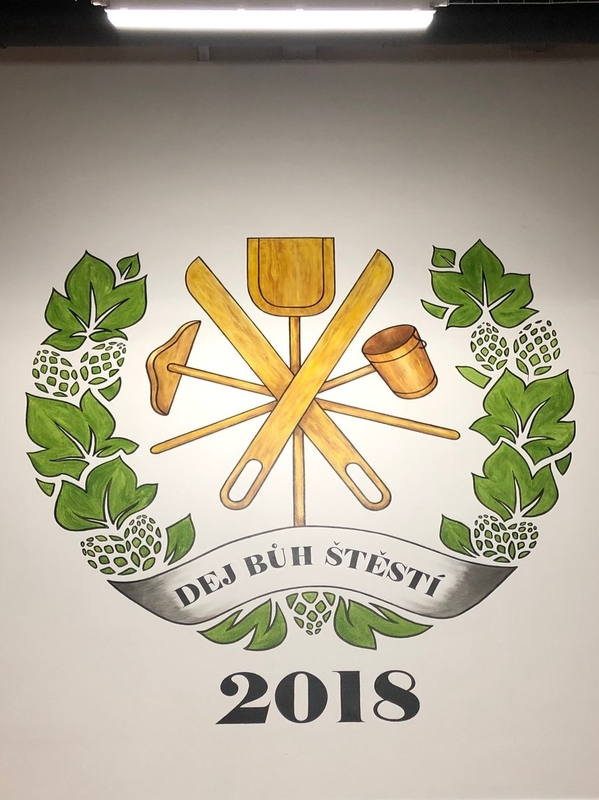£70m expansion boost for Czech Budvar
Added: Monday, July 15th 2019
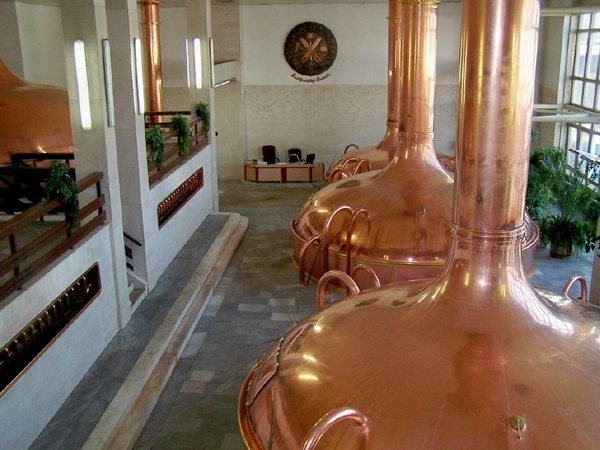
There can’t be many chief executives of major companies who would go into the kitchen to make tea for visitors. But the visitors were two Brits who declined coffee and wanted some Rosie Lea. So Petr Dvořák, boss of Budweiser Budvar, hurried away and returned with two elegant tea pots with – joy of joys – Earl Grey.
Things are looking up in the Czech Republic: not only great beer but great tea as well.
The visitors were Simon George, managing director of Budvar UK, and me. Simon, of course, was up to speed on all the developments at the brewery in České Budějovice, including the expansion plans and the never-ending trademark dispute with AB InBev, owners of American Budweiser, but I needed to be briefed.
What was once a small brewery in a small town close to the Austrian border is now a major player in world beer. Budvar exports to 80 countries and will produce 1.7 million hectolitres this year. Capacity will grow to two million hectos in 2020 when all the development work is completed.
The changes include new cellars for storing beer, a second brewhouse, modern canning and bottling lines, new warehouses and a logistics department. The cellars play a key role in the brewery’s future for everyone at Budvar is committed – with great passion – to long and slow maturation, lasting 90 days for the flagship Original while the strong, Bock-style Imperial has an impressive 200 to 300 days in the cellar.
Petr Košin, a senior member of the brewing team, took me to the new cellars and showed me the 25 enormous new lager tanks, each one holding 2,000 hectos, plus 10 smaller tanks for shorter run beers. They are fed by 24 new fermentation vessels, with a further 16 on order.
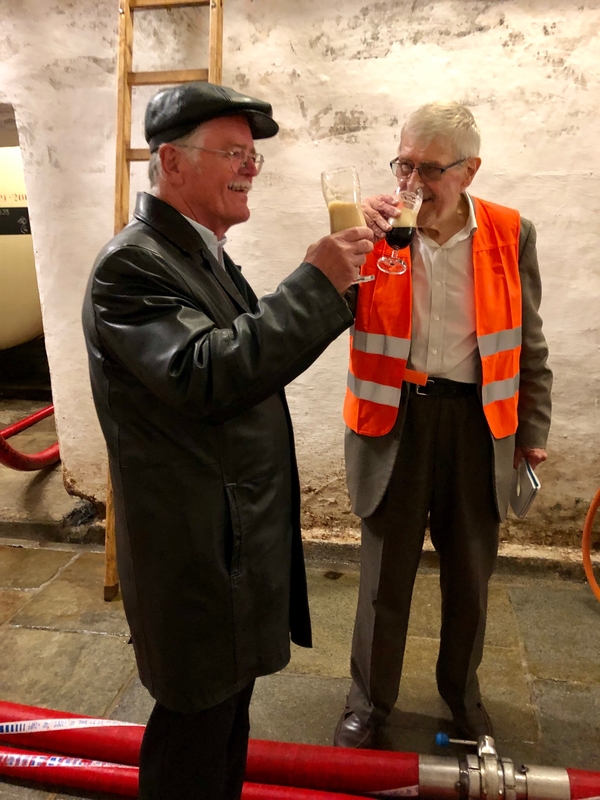
“Slow fermentation will continue!” Petr said firmly. Nodding in agreement was Josef Tolar, the retired brewmaster, who joined the brewery in 1963 when it still used wooden casks. He’s still an honoured guest and underscores Petr Košin point that the lager tanks must be horizontal ones, as yeast works faster in upright vessels and finished beer has less complexity and richness as a result. (Pictured above: Josef Tolar in the lager cellars with the author.)
En route to the cellars, we visited the brewhouse with its symphony of gleaming, burnished copper vessels where malt is mashed then boiled with hops. It will be mirrored by a second brewhouse where the vessels will have a similar copper finish. Pale malt comes from Moravia while whole hops are bought from the Žatec region, better known by its German name of Saaz. Budvar is believed to be the last brewery in the country to use whole flower hops rather than pellets or oil. Soft brewing water comes from two wells 300 metres below ground, fed by a natural, centuries-old underground reservoir. The beer is not only aged slowly, it’s brewed slowly, too, each batch taking 10 hours.
The expansion at the brewery will cost, when completed, a mighty £70 million. Budvar is still owned by the Czech government but the investment has had to come from the brewery, not the state.
“There’s no foreign money involved,” Petr Dvořák stresses. “And each stage of the development has had to be agreed by the government.” (Pictured below: Petr Dvorak presenting the author with a framed certificate thanking him for his "life-long support for the brewery".)
When I last visited Budvar there was talk of the government turning Budvar into a joint stock company in preparation for privatisation. But the government has changed and Petr Dvořák is at pains to stress that ownership remains firmly in state hands – or the Czech people’s hands, as he prefers to say.
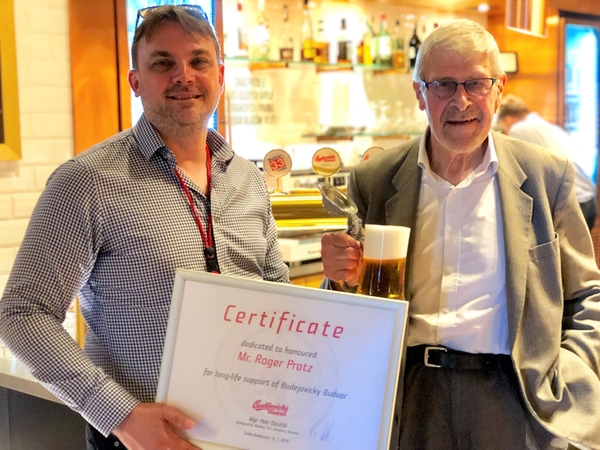
Budvar Original (5%) is the flagship beer, brewed with just Moravian barley malt and Saaz hops. It has 20 units of bitterness. A recent innovation has been tank beer, unfiltered and unpasteurised Original served from vessels that aim to deliver aromas and flavours you would find in the brewery cellars. The beer is available in selected bars in Britain.
A further innovation is Kräusened Beer, 4%, which uses an old Bavarian and Bohemian system to produce a beer with a softer palate. When the beer is maturing in the lager cellars, a proportion of unfermented Original is blended in, creating a vigorous additional fermentation. The finished result is unfiltered and unpasteurised and has a slight haze in the glass. It’s a beer that fits well with the modern demand for natural craft beer.
My visit coincided with the launch of a new beer called 33 (4.6%) – so called because it has 33 units of bitterness, high for a Budvar beer. It uses a new hop, Agnus, from the Saaz region that gives a spicy and bitter note. Unusually some crystal malt is blended with pale, a type of malt associated more with English ale than central European lager. The addition of crystal adds a biscuit note to the palate.
I pointed out that there’s a French beer called 33. It was first brewed for the export market when France had colonies in the Far East and it was big brand in Vietnam.
“The last thing you want is another trademark dispute,” I laughed.
But you don’t joke about such matters at Budvar. Petr raised an eyebrow and said: “I guess we won’t be selling it in France.”
Budvar Dark, 4.7%, is now a popular beer in both the Czech Republic and in Britain. It’s a regular beer in Bill’s restaurant chain. Dark is brewed with pale, Munich and cara malts with roasted barley, and has a rich coffee and chocolate character balanced by spicy Saaz hops.
The 7.5% Imperial comes in regular form – if a beer that rich and strong can be called regular – with a fresh hop version using hops harvested in the autumn. This version enjoys a formidable 300 days in the lager cellar and tasting it straight from a lager tank we found honey, lemon and strawberry notes on the aroma and palate.
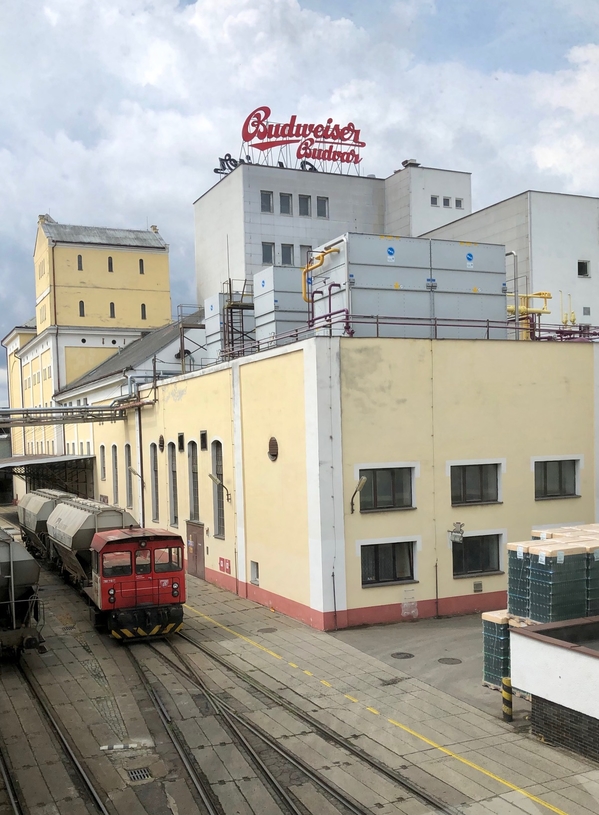
Petr Dvořák says both domestic and export sales of his beers are “buoyant. We’re exporting to 80 countries and we’re looking for new markets outside Europe. Germany is our Number One export market where we’re now the leading imported beer and sales continue to grow.” (Pictued above: the brewery with train sidings where trains bring malt from Moravia and hops from the Saaz region.)
Germany is followed by Poland, Austria, Slovakia and Russia, with Britain in fifth place. But sales in the United States are “modest” he concedes, which takes us on to the thorny and unending saga of the trademark dispute with AB InBev, owners of American Budweiser, as a result of which Budvar has to be labelled Czechvar in the U.S.
“It’s business as usual,” Petr says. “There are no major legal battles at the moment – most of the big battles are in the past. But the dispute is ongoing and we will use our elbows to get into new markets using our full name.”
He says his most recent discussion with AB InBev was brief. “They said they would consider helping us improve sales in the U.S. I said only if we can label our beer Budvar. End of discussion.”
Petr believes AB InBev is no longer pursuing the trademark dispute with such vigour in Europe as it’s turning its attention more and more to new markets. Having swallowed SABMiller – SAB stood for South African Breweries – it can now expand sales in Africa and it’s also building a major presence in China, where it employs 25 sales representatives.
One mystery surrounds AB InBev’s activities in the Czech Republic. It owns the Samson brewery in České Budějovice and is expanding capacity to 400,000 hectolitres. Even though Samson can legally brand its beers as Budweiser, its sales are modest and the expansion suggests the world’s biggest brewing corporation may be planning to move production of one of its leading brands such as Stella Artois to the plant.
As Czech drinkers are fiercely loyal to their local beers, no one at Budvar is losing sleep over the prospect of Stella arriving in the country.
And even AB InBev doesn’t have the chutzpah to call it Budweiser Stella.
A tale of two Budweisers
The South Bohemian town of České Budějovice has been a major brewing centre for centuries. It had 44 breweries in the 15th century and, under the town’s old German name of Budweis, the beers were known generically as Budweiser, just as beers from Pilsen are called Pilsner. The Royal Court Brewery was based in Budweis, enabling the products to be called “the beer of kings”.
In the 19th century a major, German-owned brewery, Budweiser Burgerbrau – the Citizen’s Brewery – made and widely exported beer under the Budweiser name. It’s now the Samson brewery.
In 1876 two German-born emigrants called Anheuser and Busch opened a brewery in St Louis, Missouri, and among its beers it had one called Budweiser, based on the Czech style. The first labels were printed in German and the beer was promoted as “the king of beers” – sound familiar?
Twenty years later, Czech speakers in Budweis opened a new brewery, the Budéjovicky Pivovar, which means the Budweis Brewery, shortened to Budvar. When the Czechs attempted to export to the U.S., Anheuser Busch took legal action against them and the trademark dispute has rumbled on ever since.
The Americans claim their original brewery in St Louis predates the opening of Budvar. The Czech response is that the term Budweiser is both historic and generic and they have superior rights to the name.
Pictured below: brewery logo in the new lager cellars.
